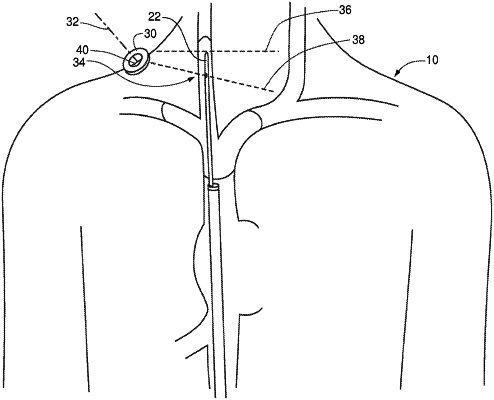| CPC A61M 25/0108 (2013.01) [A61B 5/064 (2013.01); A61B 17/3478 (2013.01); A61M 25/0136 (2013.01); A61M 25/09 (2013.01); A61M 29/02 (2013.01); A61B 17/3207 (2013.01); A61B 2017/22094 (2013.01); A61B 2017/22095 (2013.01); A61B 2090/3966 (2016.02); A61M 2025/0008 (2013.01); A61M 2025/0089 (2013.01); A61M 2025/0166 (2013.01); A61M 2029/025 (2013.01); A61M 2205/0266 (2013.01)] | 16 Claims |

|
11. A method of providing access to a central venous system of a patient comprising:
providing a catheter comprising:
a shaft having a proximal end and a distal end;
a blunt dissection tip disposed at the distal end of the shaft, the blunt dissection tip having a side aperture and a slot;
a departure angle guide tube configured to extend out the side aperture of the blunt dissection tip to set a departure angle, in a departure angle plane;
a handle coupled to the proximal end of said shaft, wherein said handle rotates said blunt dissection tip; and
a needle wire configured to extend through the departure angle guide tube, said needle wire having a sharp dissection tip permitting it to track in a substantially straight line from said departure angle guide tube;
providing a radiopaque target having a radiopaque area and a radiolucent aperture;
applying the radiopaque target to the skin of the patient so that the radiolucent aperture defines an exit point on the skin of the patient;
introducing the catheter into the patient in an entry site which is remote from the exit point and advancing the catheter to position said distal tip in a desired tip location in the central venous system;
viewing the catheter and said distal tip under fluoroscopy through the radiolucent aperture of the radiopaque target;
rotating the catheter so that the side aperture and therefore the departure angle plane is aligned with the radiolucent aperture of the radiopaque target;
adjusting the departure angle guide tube so that the departure angle is aimed at the radiolucent aperture of the radiopaque target; and
advancing the needle wire through the departure angle guide tube, through the skin of the patient, and through the radiolucent aperture of the radiopaque target thereby providing an exteriorized needle wire at said exit point.
|